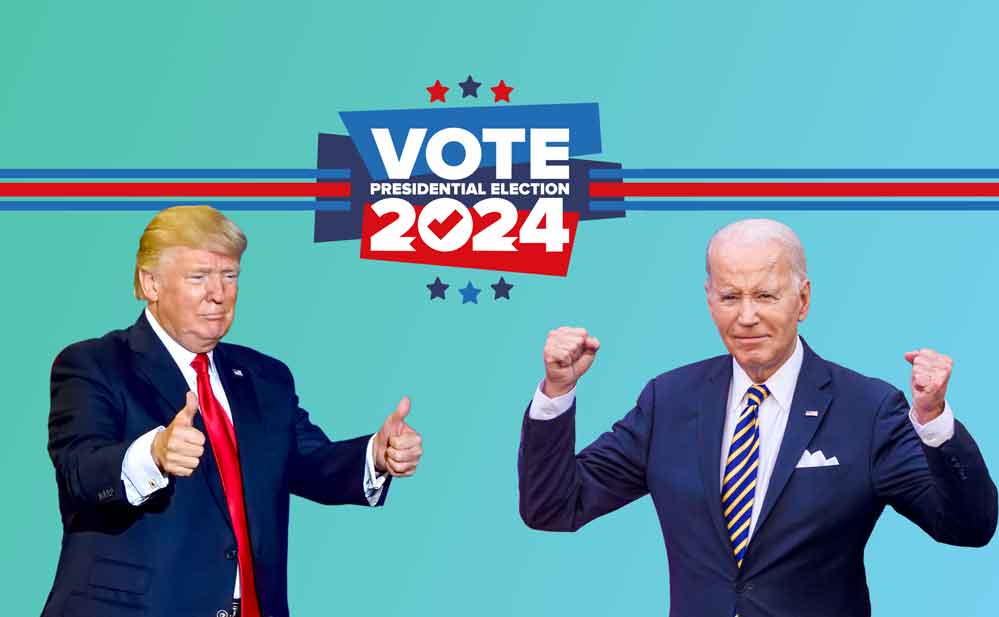How the US presidential election impacts the US dollar
The US economy is robust, but slowing. Inflation is proving sticky at levels above target. Fed rate cuts are being pushed back but the dollar and yields are steady. Into this mix will come the biggest elephant in the room: the election.

>> Factors drive the US dollar
The US economy has outperformed expectations but it is slowing. Annualised growth was 4.9% in Q3 2023, 3.4% in Q4, and is expected to be around 2.5% in Q1 this year. So, for all this talk of robustness and exceptionalism relative to other G10 countries, there are stresses and strains. The sort of stresses, for instance, that currently put optimism amongst small businesses down at its lowest levels in over a decade. This is helping to reduce inflationary pressure but it is clear, particularly from price data so far this year, that the ‘last mile’ of inflation reduction that’s needed to reach the 2% target, is proving the hardest. This is not surprising at all.
Many indicators of current and future prices are simply at odds with the idea that inflation can smoothly descend to the 2% region. Inflation is proving sticky, and there’s no better way to see this than the ‘sticky’ price CPI measure produced by the Atlanta Fed. It tracks just the ‘slow moving’ components of the CPI to try to gauge underlying price pressures.
The data shows that periods when headline CPI inflation has been close to the 2% target, such as that seen before the pandemic, have been consistent with sticky-price inflation in the region of 2-3% for the most part. But now the 3-month annualised rate is running at over 5% and, what’s more, it has picked up in recent months.
While we do expect this measure to turn down again, the price picture is turning out as expected, by which we mean that inflation is unlikely to sustainably sit at the 2% target. Instead, it will hover above the 2% target, and just how far it hovers above target will likely dictate how Fed policy will respond. Disappointing inflation data in recent months has pushed back the starting point for rate cuts, according to the futures market, and reduced the number of cuts anticipated.
The market is just about hanging onto the idea that rate cuts can begin in September, and that there will be two 25-bps cuts in all this year. “We lean to the more optimistic side of this assessment, which is opposite to the position we took earlier in the year when the market was priced for five or six rate cuts in 2024. Our current assumption is that the Fed will start to cut rates in September and reduce the policy rate three times, by 75-bps in all through the course of this year. We acknowledge that if the Fed does cut rates in the last three meetings of the year, it would be trimming rates both just ahead and not long after the US election which occurs on November 5th. This could lead to accusations of political bias, particularly by Republican candidate and former president Trump, but we do not believe that the Fed will gerrymander policy to try to avoid any such criticism”, said Steve Barrow, Head of the Standard Bank G10 Strategy.
>> How will a Trump comeback affect the US dollar?
The US dollar has remained very stable over the past year or more, particularly against the likes of the euro and the pound, and that’s in spite of rate-cut expectations having been cut back significantly. Other central banks, particularly the ECB, seem likely to jump ahead of the Fed and cut rates first, but Steve Barrow does not believe that this will engender significant strength in the US dollar. One reason for this is that the FX market – and indeed many US domestic markets such as treasuries and equities – will be transfixed in the headlights of the coming US election juggernaut in November.
For the US dollar, in Steve Barrow’s view, a Trump victory could lead to the same sort of spurt in the greenback, as we saw when he won the presidency in 2016, but equally, a win for Biden could create temporary dollar weakness, just as we saw when he won in 2020.
In short, a shake-up in the US dollar is likely to come from politics, not monetary policy and, as Steve Barrow erres to the view that Biden will cling on to power, his bias is for a weaker dollar once this current period of stability comes to an end. He also believes that the advantages that the US dollar has at the moment, such as US economic exceptionalism and high policy rates, will wane over time, and that should permit a 5-10% fall in the US dollar’s effective exchange rate over the next year or two.








